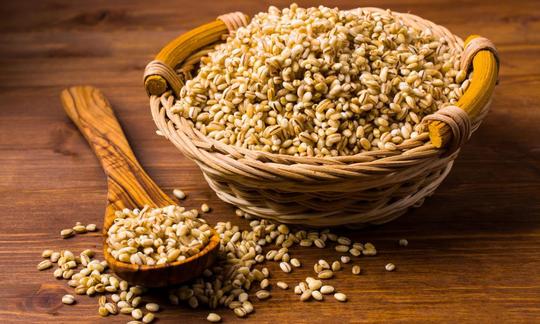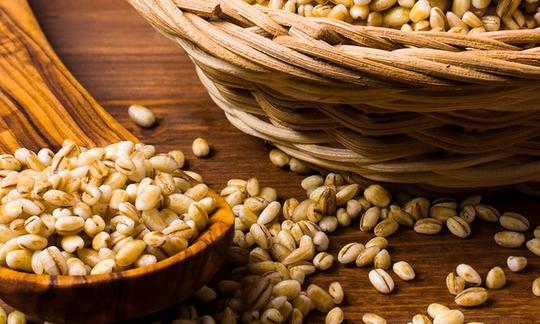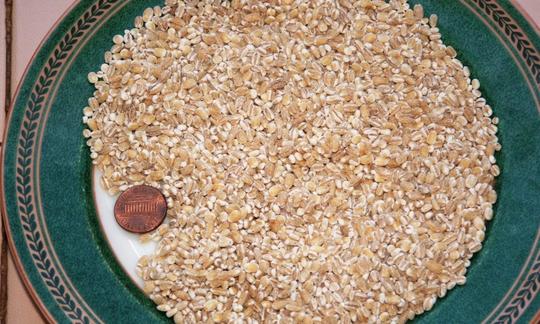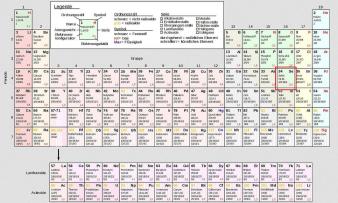Table of contents
Barley groats or rolled barley ( raw?) are peeled, ground and polished barley grains ( organic) whose nutrient content is noticeably lower than that of whole grain barley due to the removal of the outer layers. The nutty-tasting grains are very filling due to the fiber and stimulate intestinal activity.
Using barley groats in the kitchen:
When cooked, rolled barley or barley groats have a firm consistency and are used in both savoury and sweet dishes. The peeled and polished barley grains can be used warm in porridge, soups, stews and casseroles after cooking, or cold in salads. Barley groats also taste delicious as a rice substitute in risotto, also known as orzo risotto or barley risotto.
Can you eat barley raw? Yes, you can eat barley raw if you soak the barley grains and/or let them germinate. But only unpolished, whole barley grains, such as naked barley, 18 are whole grain and capable of germinating: They make a good raw food base. You can find out more about the germination process in our ingredient barley. Since barley groats are processed grains, they are not suitable for germination and are therefore mainly used in cooked dishes.
You can make barley flour from pearl barley, just like from hulled barley. The flour has a light golden color and a nutty flavor. Since barley flour contains only small amounts of gluten (important for the flour's good baking properties), barley flour can be combined with other types of flour that contain gluten to improve its baking properties. Muffins, pancakes and waffles can contain up to 50% barley flour. In yeast bread, the barley flour content should not exceed 25%.
You will find simple, vegan pearl barley recipes and barley groats recipes later in this article. For those who like sweet things: peeled pearl barley also works well in desserts. A warm porridge, served with fresh fruit, nuts and seeds, makes a healthy and filling breakfast.
The spices cinnamon, garlic, marjoram, parsley and thyme go well with the taste of the barley.
Vegan recipe for porridge with pearl barley and fruit:
Ingredients (for 4 people): 1 l almond milk (or oat milk), 1 small pineapple (organic), 1 fresh mango, 400 g strawberries (organic), 300 g grapes, 250 g pearl barley (organic), 4 stalks of lemon balm.
Preparation: First, bring the pearl barley to the boil in a saucepan with the almond milk and simmer for 25 minutes. In the meantime, peel the pineapple, remove the stalk and cut the fruit into slices. Next, wash, clean and dice the strawberries. Wash and halve the grapes. Cut the stone from the mango, peel and dice the flesh. Wash the lemon balm and pluck the leaves from the stems. Put the vegan pearl barley porridge in a bowl and top it with the fruit (raw) and the lemon balm. The vegan pearl barley porridge is ready.
Vegan pearl barley recipe for barley soup:
Ingredients (for 4 people): 1.5 l vegetable stock, 200 g red lentils (organic), 150 g pearl barley (organic), 2 onions, 2 cloves of garlic, 2 tbsp rapeseed oil, 2 tbsp fresh parsley (organic), 1 tbsp turmeric, 1 tsp cumin,black pepper, salt.
Preparation: For this pearl barley recipe, first peel the garlic and onions, chop finely and sauté in the pan. Add cumin and turmeric and mix everything together well. Deglaze the onion-garlic mixture with spice broth and stir in the pearl barley. Let the soup simmer for about 30 minutes. Add the lentils and let everything simmer for another 25 minutes until the lentils and pearl barley are cooked. Add a little more vegetable broth if necessary. Finally, add the chopped parsley to the vegan pearl barley soup and season with salt and pepper.
Vegan recipes with barley groats or pearl barley can be found under the note: " Recipes that have the most of this ingredient ".
| Not only vegans or vegetarians should read this: Vegans often eat unhealthily. Avoidable nutritional mistakes. |
Shopping - where to buy pearl barley (rolled barley)?
Where can you buy pearl barley? Pearled barley (peeled barley, barley pearls, cooking barley) is available all year round in supermarkets such as Coop, Migros, InterSpar, Edeka, Rewe. Major retailers such as Denner, Volg, Aldi, Lidl, Hofer do not currently have peeled pearl barley in their range (as of May 2021). Organic barley (raw?) can be found in health food stores, organic shops, organic supermarkets ( Denn's Biomarkt, Alnatura) and in many online stores (sometimes also labeled as "barley pearls").
Pearl barley is available in different degrees of fineness: extra coarse, coarse, medium, fine and extra fine. The finest barley variety is pearl barley (pearl barley). However, the everyday use of the term pearl barley is not strictly regulated. It is possible that coarser barley is also sold in stores under the name pearl barley.
A ground barley grain (rolled barley) can also be distinguished by its shape. There are round, half-round and elongated barley groats. 1 The different variations of rolled barley are available on some websites or in organic shops, health food stores and organic supermarkets ( Denn's Biomarkt, Alnatura).
Your own preparation:
The preparation of barley groats depends on the fineness of the groats. The coarser the rolled barley, the longer the cooking time. First, rinse the barley groats thoroughly to remove excess starch. If you are cooking barley groats risotto, you should only rinse the groats very briefly, as starch is necessary for the creamy texture of the barley risotto.
How do you prepare pearl barley? Fine barley groats can be cooked straight away, without soaking first. To do this, heat lightly salted water in a pan and add the groats. Let everything simmer for 30 minutes, then you can pour off the cooking water and serve the pearl barley. 2 Coarse pearl barley takes up to an hour to cook without being soaked. Soaking the groats (6-8 hours) can reduce the cooking time to 45 minutes. 3 Soaking also reduces the phytic acid contained in the pearl barley. You can find out more about phytic acid in the article Phytic acid or phytate and soaking or sprouting.
Storage:
Store hulled pearl barley, just like whole barley grains, in a dry, cool place. Under good storage conditions, it will last for several years. A dark cellar or a cool pantry is suitable for storage. Check the pearl barley regularly for pests. 4 Store cooked pearl barley or soup in an airtight container in the refrigerator and use the pearl barley within 3-5 days.
Ingredients - nutritional values of pearl barley - calories:
There are major differences in the composition of ingredients depending on the cultivar (genetics) and origin (environmental conditions), which in the case of barley are not primarily limited to the processing method. According to scientific studies, the protein content of whole grain barley varies between 10 and 20% and the fiber content even between 11 and 34% (of which beta-glucan is 2-11%). The following comparisons are based on data from the United States Department of Agriculture - but may differ from European products. 5,17
Pearl barley nutrients: 100 g of barley barley (raw?) consists of 78 g of carbohydrates and has an energy content of 352 kcal when uncooked. Other nutritional values of barley barley include 16 g of fiber and 1.2 g of fat. With 9.9 g of protein, barley barley contains about as much protein as ordinary breadcrumbs (10.1 g/100g) and corn kernels (9.4 g/100g). Hulled barley (12.5 g/100g) and the pseudocereal amaranth (14.1 g/100g) are slightly richer in protein. 5
Barley groats contain 38 µg/100g of selenium, which makes up 69% of the daily requirement. A similar amount can be found in wheat gluten (39.7 µg/100g) and wheat flour (39.7 µg/100g). Raw kamut or khorasan wheat contains significantly more selenium at 81.5 µg/100g. 5
The proportion of tryptophan accounts for around 67% of the daily requirement when consuming 100 g of pearl barley (and a daily intake of around 2000 kcal). The content of 0.16 g/100g can be compared with raw quinoa. Hemp seeds (0.37 g/100g) and chia seeds (0.44 g/100g) have a high tryptophan content. 5
The 1.3 mg of manganese contained in 100 g covers 66% of the daily human requirement. Wild rice (raw) has a comparable amount. The content is significantly higher in wheat bran (11.5 mg/100g). 5
The protein phenylalanine is contained in barley groats at 0.56 g/100g, which makes up 36% of the daily requirement. This nutritional value of groats can be compared with millet (raw) and sorghum. The proportion is significantly higher in ripe seeds of raw mung beans (1.4 g/100g) and in ripe seeds of soy beans (2.1 g/100g).
The complete figures for barley groats or rolled barley (ingredients), the coverage of the daily requirement and comparison values with other ingredients can be found in our nutrient tables. In the article Nutrients explained you will get a detailed insight into the topic.
Health aspects - effects:
Is pearl barley healthy or are barley groats healthy? Pearl barley contains fewer vitamins and minerals than dehulled barley, because the nutrient-rich outer layers are removed during production (not whole grain). Nevertheless, barley groats contain large amounts of fiber and healthy proteins, which have a satiating effect, increase intestinal volume and stimulate intestinal activity. Pearl barley can therefore be counted among the healthy foods.
Barley groats also contain a high proportion of beta-glucan, a dietary fibre that supports the immune system and reduces the risk of arteriosclerosis, cardiovascular disease, neurodegenerative diseases, diabetes and cancer. 16 The dietary fibre also has a cholesterol-lowering effect. 6 Like hulled barley, groats can relieve digestive complaints such as inflammation of the stomach lining (gastritis), digestive problems, duodenal ulcers, inflammation of the stomach and intestines and inflammation of the colon. 7
Dangers - Intolerances - Side effects:
Is pearl barley gluten-free? / Does pearl barley contain gluten? Barley groats contain less gluten than wheat and spelt ; however, people who suffer from celiac disease should still avoid eating the groats. 8 You can find more information about the food intolerance celiac disease in the article Semolina, raw (organic?).
Folk medicine - naturopathy:
Barley groats (sg. barley groats) are also used in naturopathy in the form of barley water. Barley water is considered an ancient remedy that was used in the past to reduce fever and strengthen the body. Barley water is said to have a cooling, moisturizing effect. 9 You can find a recipe for barley water under the ingredient barley.
Pearl barley can be used to make an easily digestible, strengthening porridge or barley soup, which is why pearl barley is used in naturopathy to strengthen the body during and after illnesses.
Occurrence - Origin:
Like wheat, the barley plant ( Hordeum vulgare L.) belongs to the grass family (Poaceae). Barley originally comes from the Middle East and is considered one of the oldest cultivated grains. 10 Along with emmer and einkorn, barley is one of the ancient grains. People are said to have been cultivating the nutritious grains for around 6,000 years. In ancient Egypt, barley was considered a staple food and for the Greeks it was also one of the most important grains.
Industrial production:
What is barley groats? The term groats or barley groats is usually used in the plural 13 : Barley groats are small, ground grains (made of barley) with a round, semi-round or elongated-round shape that can resemble rice grains in appearance. This rolled barley is made from harvested and cleaned barley grains that have previously been dehusked (i.e. freed from the inedible husks surrounding the grain). The grains are then dehusked, ground and polished using groats mills. The groats mill removes the germ and outer layers from the grains. Since the outer layers of the grain contain most of the nutrients, many of the barley's vitamins and minerals are lost during the peeling and grinding process. Nevertheless, rolled barley is a very high-fiber and filling side dish and is easier to digest thanks to the removal of the outer layers. 11 We found no information on the effective grinding temperatures.
In order to preserve more nutrients in the barley groats, the parboiled process is used, as with rice. Here, the barley grains are first placed in warm water and then treated with high pressure. The water-soluble ingredients from the outer layers, such as B vitamins and minerals, are then partially concentrated inside the barley grain. Treatment with steam pressure hardens the starch on the surface of the barley grain, which means that the nutrients are retained even after the groats have been peeled and ground (higher nutritional value). Parboiled barley groats are a healthier alternative to conventional rolled barley and are available in online shops, for example. 12
General information on pearl barley:
What is pearl barley? In the German retail trade, the term "pearl barley" primarily refers to processed barley grains of the "summer barley". This term refers primarily to two-row barley ( Hordeum vulgare f. distichon or ssp. distichon, sometimes also distichum). There is also another subspecies of cultivated barley, which has the botanical name "rolled barley", namely the six-row barley ( Hordeum vulgare f. hexastichon or ssp. hexastichon, In contrast to two-row barley, this develops up to three grains per ear instead of one grain - but these are less developed and contain, among other things, less starch. Therefore, when using the term "rolled barley", one must differentiate between the botanical name and the mechanical processing method.
The term pearl barley or cooking barley (often also called hulled pearl barley) refers to the whole, hulled and polished barley grain. Pearl barley or pearl barley, on the other hand, is crushed barley grains that have been divided into two to four pieces before the grinding process and then polished. 15 Even with a gentle production process, the nutritional values of pearl barley are lower than those of the original product.
What is pearl barley? The word pearl barley probably comes from the Slavic language and is derived from the word krupa (grain barley): It means something like hailstone 13 and groats. 1 4 The peeled and polished pearl barley can consist not only of barley, but also of wheat. Pearl barley used to be considered poor man's food, but today it is slowly becoming more popular in our kitchens. Pearl barley or barley groats are usually plural (several grains), while barley or pearl barley as a collective term is almost exclusively singular.
Alternative names for pearl barley:
Coarse barley is also known colloquially as calf's teeth. Fine barley is known as pearl barley. In Austria, pearl barley is also known as rolled barley. In English, pearl barley is called pearl barley or pearled barley.
On the Internet you can find incorrect spellings such as rolled barley, rolled barley, rolled barley, rolled barley (plural) and barley groats - but also search queries such as: barley nutritional values, barley nutritional value, rolled barley recipes or rolled barley soup.
Literature - Sources:
Bibliography - 17 Sources
| 1. | Wilfried Seibel (Hrsg.): Warenkunde Getreide. AgriMedia, Bergen/Dumme 2005. |
| 2. | Muellers-muehle.de Gerstengraupen. |
| 3. | Limafood.com Gerstengraupen. |
| 4. | Getreide.org Getreide lagern – So geht es richtig. |
| 5. | USDA United States Department of Agriculture. |
| 6. | Ames NP, Rhymer CR. Issues surrounding health claims for barley. J Nutr. 2008 Jun;138(6):1237S-43S. |
| 7. | Pamplona Roger JD. Heilkräfte der Nahrung, Praxishandbuch. Advent-Verlag Zürich. 3. Auflage 2008. |
| 8. | Rubio-Tapia A, Hill ID, Kelly CP, Calderwood AH, Murray JA. ACG clinical guidelines: diagnosis and management of celiac disease. Am J Gastroenterol. Mai 2013; 108(5): 656–76. |
| 9. | Heilpraxisnet.de Gerstenwasser – Wirkung und Anwendung. 2019. |
| 10. | Lister DL, Jones H, Oliveira HR, Petrie CA, Liu X, Cockram J, u. a. Barley heads east: Genetic analyses reveal routes of spread through diverse Eurasian landscapes. PLoS One [Internet]. 18. Juli 2018. |
| 11. | Getreide.org Graupen. |
| 12. | Spektrum.de Parboiling-Verfahren. |
| 13. | Dwds.de Graupe, die. |
| 15. | Verbraucherservice-bayern.de Graupen - Körner mit Schliff. 2016. |
| 16. | Baldassano S, Accardi G, Vasto S. Beta-glucans and cancer: The influence of inflammation and gut peptide. Eur J Med Chem. 15. Dezember 2017; 142: 486–92. |
| 17. | The increasing use of barley and barley by-products in the production of healthier baked goods. Trends in Food Science & Technology. 1. Februar 2013;29(2):124–34. |
| 18. | Meints B, Hayes PM. Breeding Naked Barley for Food, Feed, and Malt. Plant Breeding Reviews. 2019; 43: 95–119. |













Comments